This site uses cookies as defined in our Cookie Policy, by continuing to use this site you agree to their use.
Continue
| Arrive | Depart | ||||||
| 21st21 | FebFeb | 202525 | Sydney, New South Wales, Australia, embark on the Diamond Princess | 16:00 | |||
Sydney belongs to the exclusive club of cities that generate excitement. At the end of a marathon flight there's renewed vitality in the cabin as the plane circles the city, where thousands of yachts are suspended on the dark water and the sails of the Opera House glisten in the distance. Blessed with dazzling beaches and a sunny climate, Sydney is among the most beautiful cities on the planet.With 4.6 million people, Sydney is the biggest and most cosmopolitan city in Australia. A wave of immigration from the 1950s has seen the Anglo-Irish immigrants who made up the city's original population joined by Italians, Greeks, Turks, Lebanese, Chinese, Vietnamese, Thais, and Indonesians. This intermingling has created a cultural vibrancy and energy—and a culinary repertoire—that was missing only a generation ago.Sydneysiders embrace their harbor with a passion. Indented with numerous bays and beaches, Sydney Harbour is the presiding icon for the city, and urban Australia. Captain Arthur Phillip, commander of the 11-ship First Fleet, wrote in his diary when he first set eyes on the harbor on January 26, 1788: "We had the satisfaction of finding the finest harbor in the world."Although a visit to Sydney is an essential part of an Australian experience, the city is no more representative of Australia than Los Angeles is of the United States. Sydney has joined the ranks of the great cities whose characters are essentially international. What Sydney offers is style, sophistication, and great looks—an exhilarating prelude to the continent at its back door. | |||||||
| 22nd22 | FebFeb | 202525 | At Sea | ||||
| 23rd23 | FebFeb | 202525 | At Sea | ||||
| 24th24 | FebFeb | 202525 | At Sea | ||||
| 25th25 | FebFeb | 202525 | Alotau, Papua New Guinea | 07:00 | 18:00 | ||
Alotau is the provincial capital of the Milne Bay Province located in the southeast bay of Papua New Guinea. The town and surrounding area has been an important staging ground during World War II and we will see remains and memorials dating back or referring to the war. On a tour of the town, visitors will appreciate lovely vistas of the bay and experience the markets, which are frequented not only by locals, but also by islanders selling their products or looking for produce to take back into Milne Bay. Alotau is an important port facility for the islands and attracts many vendors of handicrafts from different islands. | |||||||
| 26th26 | FebFeb | 202525 | Conflict Island Group, Papua New Guinea | 07:00 | 18:00 | ||
| 27th27 | FebFeb | 202525 | At Sea | ||||
| 28th28 | FebFeb | 202525 | At Sea | ||||
| 1st01 | MarMar | 202525 | At Sea | ||||
| 2nd02 | MarMar | 202525 | At Sea | ||||
| 3rd03 | MarMar | 202525 | At Sea | ||||
| 4th04 | MarMar | 202525 | At Sea | ||||
| 5th05 | MarMar | 202525 | Manila, Philippines | 08:00 | 18:00 | ||
MANILA, the capital city of the Philippines, was founded in, 1571 by Spanish conquistador Miguel López de Legazpi. It is one of the oldest cities in the country and was the seat of power for most of the colonial rules of the Philippines. It is situated on the eastern shore of Manila Bay and contains a multitude of landmarks, some of which date back to the 16th century. It is home to the baroque 16th-century San Agustin Church as well as Fort Santiago, a storied citadel and military prison. In the 19th century Manila became one of the most modern cities in Asia. Before the Spanish–American War, Manila saw the rise of the Philippine Revolution. Under the American rule following the Spanish-American War, the United States changed the official language from Spanish to English. Towards the end of World War II, during the Battle of Manila, most of the city was flattened by intensive aerial bombardment. Today, tourism is a vital industry in Manila. Major shopping malls and bazaars thrive around Manila. | |||||||
| 6th06 | MarMar | 202525 | At Sea | ||||
| 7th07 | MarMar | 202525 | Hong Kong, Hong Kong | 07:00 | 23:00 | ||
The Hong Kong Island skyline, with its ever-growing number of skyscrapers, speaks to ambition and money. Paris, London, even New York were centuries in the making, while Hong Kong's towers, bright lights, and glitzy shopping emporia weren't yet part of the urban scene when many of the young investment bankers who fuel one of the world's leading financial centers were born. Commerce is concentrated in the glittering high-rises of Central, tucked between Victoria Harbor and forested peaks on Hong Kong Island's north shore. While it's easy to think all the bright lights are the sum of today's Hong Kong, you need only walk or board a tram for the short jaunt west into Western to discover a side of Hong Kong that is more traditionally Chinese but no less high-energy. You'll discover the real Hong Kong to the east of Central, too, in Wan Chai, Causeway Bay, and beyond. Amid the residential towers are restaurants, shopping malls, bars, convention centers, a nice smattering of museums, and—depending on fate and the horse you wager on—one of Hong Kong's luckiest or unluckiest spots, the Happy Valley Racecourse. Kowloon sprawls across a generous swath of the Chinese mainland across Victoria Harbour from Central. Tsim Sha Tsui, at the tip of Kowloon peninsula, is packed with glitzy shops, first-rate museums, and eye-popping views of the skyline across the water. Just to the north are the teeming market streets of Mong Kok and in the dense residential neighborhoods beyond, two of Hong Kong's most enchanting spiritual sights, Wong Tai Sin Temple and Chi Lin Nunnery. As you navigate this huge metropolis (easy to do on the excellent transportation network), keep in mind that streets are usually numbered odd on one side, even on the other. There's no baseline for street numbers and no block-based numbering system, but street signs indicate building numbers for any given block. | |||||||
| 8th08 | MarMar | 202525 | At Sea | ||||
| 9th09 | MarMar | 202525 | Keelung (Chilung), Taiwan | 07:00 | 18:00 | ||
With the glittering lights of Taipei - a futuristic metropolis of culture and ideas - sparkling nearby, Keelung is the first calling point for many visitors arriving in Taiwan. While this port city essentially serves as Taipei's ocean gateway, you shouldn’t be too hasty in dashing off to Taipei's neon-lit magic – first it’s well worth spending some time exploring the famous glowing night market, which hums with life each evening and is famous for its local seafood. | |||||||
| 10th10 | MarMar | 202525 | At Sea | ||||
| 11th11 | MarMar | 202525 | Kagoshima, Japan | 08:00 | 18:00 | ||
Kagoshima city is the capital of Kagoshima prefecture and also Kyushu’s southernmost major city. This city is often compared to its Italian sister city Naples, due to its’s similarities such as mild climate and active volcano, Sakurajima. Sakurajima is one of the most renowned active volcanos not only in Japan but also in the whole entire world. This smoking Sakurajima is centred in Kinko Bay and is one of the main symbols of this prefecture. We cannot talk about Sakurajima without the history of continuous eruption. Sakurajima used to be an isolated island; however, the land has banded together with Osumi peninsula from the eruption in 1914. You may have a chance to see the smoke coming from the top of Sakurajima depending on the weather condition. Not only does the scenery of Sakurajima represent the beauty of Kagoshima City but Senganen garden is also symbolic to elegance in the Kagoshima region. This Japanese garden was constructed by a feudal lord, Mitsuhisa Shimazu, as a guest house of the Kagoshima castle which attracts many visitors for its splendid view. | |||||||
| 12th12 | MarMar | 202525 | At Sea | ||||
| 13th13 | MarMar | 202525 | Kobe, Japan | 07:00 | 19:00 | ||
Located on the calm waters of the Inland Sea, Kobe has served as an important port town for hundreds of years. It was one of the first harbours to accept foreign traders in 1868 when Japan was just emerging from its centuries of isolation. What followed was a surge of Western trade and exports. Today, Kobe is quite multicultural, with expatriates from 98 different nations in residence, providing a cultural diversity most easily visible in restaurants serving every kind of cuisine, including the now world famous Kobe beef. The Great Hanshin Earthquake of 1995 set back Kobe’s development, but not for long. Kobe emerged more vibrant than before - with additional attractions, hotels and urban redevelopment, and only a few remnants of the extensive damage. It is a cosmopolitan place with lively shopping arcades, interesting museums, great restaurants, and a port that is still at the heart of things. Kobe is well known for its nightlife, in an intimate quarter of neon lights, cosy bars and sophisticated nightclubs. It also serves as the gateway to the ancient Japanese capitals of Kyoto and Nara. | |||||||
| 14th14 | MarMar | 202525 | Shimizu, Japan | 13:00 | 21:00 | ||
The salt and pepper cone of Japan's most famous natural landmark won’t fail to take your breath away, as it soars into the sky in a vision of spectacular symmetry. Make sure your camera is fully prepared before you dock in Shimizu’s port, where unparalleled views of the extraordinary Mount Fuji’s dramatic peak await. Take your time to soak up one of Japan's most iconic views, before dipping your toes into the rest of what this destination of tranquil temples has to offer. While there’s a bustling fish market, and a charming amusement park waiting close to the port, most new arrivals immediately set off in pursuit of the best views of Mount Fuji, or to see the stunning panorama on offer from the heights of the Kunozan Toshogu Shrine. Take the cable car up to the top, to experience the tranquillity around the forested shrine, and to enjoy its stunning architecture of deep scarlets and gleaming golds. You can also enjoy heart-stopping views out over the Bay of Suruga, and the tea plantations below. | |||||||
| 15th15 | MarMar | 202525 | Yokohama, Japan, disembark the Diamond Princess | 06:30 | |||
In 1853, a fleet of four American warships under Commodore Matthew Perry sailed into the bay of Tokyo (then Edo) and presented the reluctant Japanese with the demands of the U.S. government for the opening of diplomatic and commercial relations. The following year Perry returned and first set foot on Japanese soil at Yokohama—then a small fishing village on the mudflats of Tokyo bay. Two years later New York businessman Townsend Harris became America's first diplomatic representative to Japan. In 1858 he was finally able to negotiate a commercial treaty between the two countries; part of the deal designated four locations—one of them Yokohama—as treaty ports. In 1859 the shogunate created a special settlement in Yokohama for the growing community of merchants, traders, missionaries, and other assorted adventurers drawn to this exotic new land of opportunity. The foreigners (predominantly Chinese and British, plus a few French, Americans, and Dutch) were confined here to a guarded compound about 5 square km (2 square miles)—placed, in effect, in isolation—but not for long. Within a few short years the shogunal government collapsed, and Japan began to modernize. Western ideas were welcomed, as were Western goods, and the little treaty port became Japan's principal gateway to the outside world. In 1872 Japan's first railway was built, linking Yokohama and Tokyo. In 1889 Yokohama became a city; by then the population had grown to some 120,000. As the city prospered, so did the international community and by the early 1900s Yokohama was the busiest and most modern center of international trade in all of East Asia. Then Yokohama came tumbling down. On September 1, 1923, the Great Kanto Earthquake devastated the city. The ensuing fires destroyed some 60,000 homes and took more than 40,000 lives. During the six years it took to rebuild the city, many foreign businesses took up quarters elsewhere, primarily in Kobe and Osaka, and did not return. Over the next 20 years Yokohama continued to grow as an industrial center—until May 29, 1945, when in a span of four hours, some 500 American B-29 bombers leveled nearly half the city and left more than half a million people homeless. When the war ended, what remained became—in effect—the center of the Allied occupation. General Douglas MacArthur set up headquarters here, briefly, before moving to Tokyo; the entire port facility and about a quarter of the city remained in the hands of the U.S. military throughout the 1950s. By the 1970s Yokohama was once more rising from the debris; in 1978 it surpassed Osaka as the nation's second-largest city, and the population is now inching up to the 3.5 million mark. Boosted by Japan's postwar economic miracle, Yokohama has extended its urban sprawl north to Tokyo and south to Kamakura—in the process creating a whole new subcenter around the Shinkansen Station at Shin-Yokohama. The development of air travel and the competition from other ports have changed the city's role in Japan's economy. The great liners that once docked at Yokohama's piers are now but a memory, kept alive by a museum ship and the occasional visit of a luxury vessel on a Pacific cruise. Modern Large as Yokohama is, the central area is very negotiable. As with any other port city, much of what it has to offer centers on the waterfront—in this case, on the west side of Tokyo Bay. The downtown area is called Kannai (literally, "within the checkpoint"); this is where the international community was originally confined by the shogunate. Though the center of interest has expanded to include the waterfront and Ishikawa-cho, to the south, Kannai remains the heart of town. Think of that heart as two adjacent areas. One is the old district of Kannai, bounded by Basha-michi on the northwest and Nippon-odori on the southeast, the Keihin Tohoku Line tracks on the southwest, and the waterfront on the northeast. This area contains the business offices of modern Yokohama. The other area extends southeast from Nippon-odori to the Moto-machi shopping street and the International Cemetery, bordered by Yamashita Koen and the waterfront to the northeast; in the center is Chinatown, with Ishikawa-cho Station to the southwest. This is the most interesting part of town for tourists. Whether you're coming from Tokyo, Nagoya, or Kamakura, make Ishikawa-cho Station your starting point. Take the South Exit from the station and head in the direction of the waterfront. | |||||||
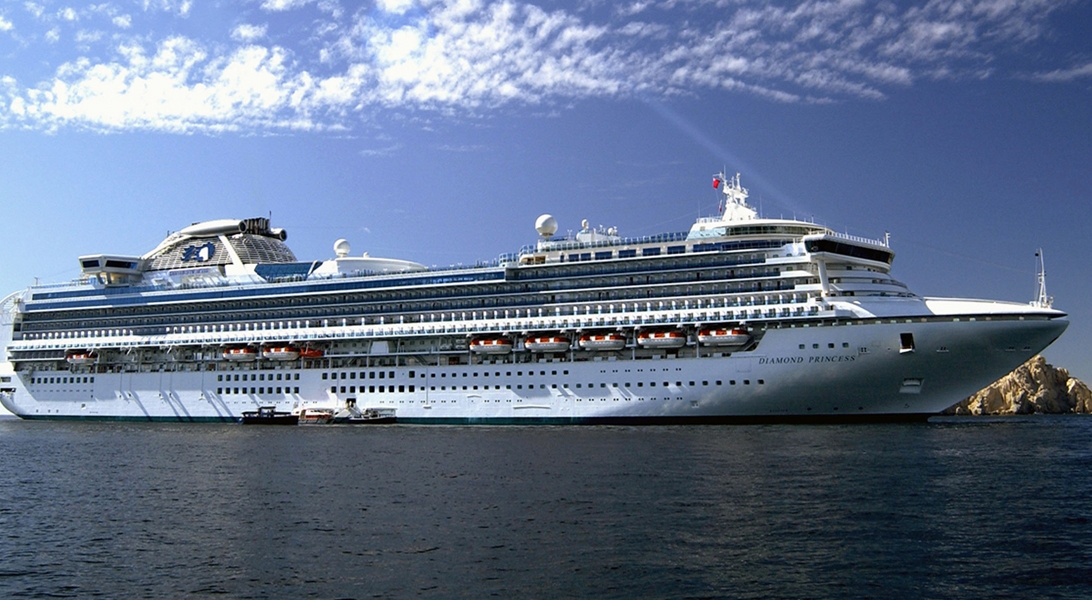
The images shown are for illustration purposes only and may not be an exact representation of what you find on the ship.

| Grade Code | From | To | |
| IF | Interior | £1,939 | £3,039 |
| IE | Interior | £1,968 | £3,068 |
| ID | Interior | £1,999 | £3,099 |
| IC | Interior | £2,031 | £3,131 |
| IB | Interior | £2,062 | £3,162 |
| IA | Interior | £2,094 | £3,194 |
These staterooms are the perfect place to recharge your batteries. Our most affordable option, featuring two twin beds or a queen-size bed. Other amenities include a refrigerator, hair dryer, TV, closet and bathroom with shower.
Stateroom features:
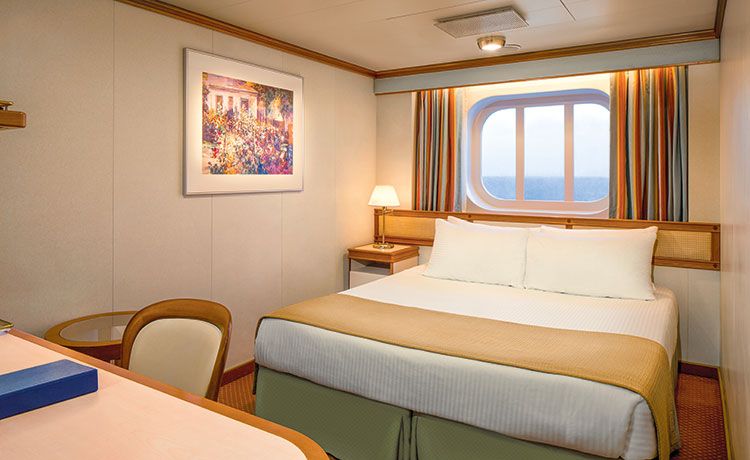
| Grade Code | From | To | |
| OZ | Oceanview (Obstructed) | £1,937 | £3,037 |
| OY | Oceanview (Obstructed) | £1,968 | £3,068 |
| OW | Oceanview (Obstructed) | £1,999 | £3,099 |
| OV | Oceanview (Obstructed) | £2,031 | £3,131 |
| OF | Oceanview | £2,579 | £3,679 |
| OC | Oceanview | £2,738 | £3,838 |
| O5 | Premium Oceanview | £2,902 | £4,002 |
Enjoy the added benefit of a view of the ocean from either a picture window or porthole that brings in natural light. This stateroom includes all the amenities of an interior room.
Stateroom features:
The images shown are for illustration purposes only and may not be an exact representation of what you find on the ship.

An exquisitely decorated traditional sushi bar, serving up sushi and sashimi expertly prepared before your eyes. Dine at the sushi bar or enjoy an elegant restaurant experience.
Additional charge applies.
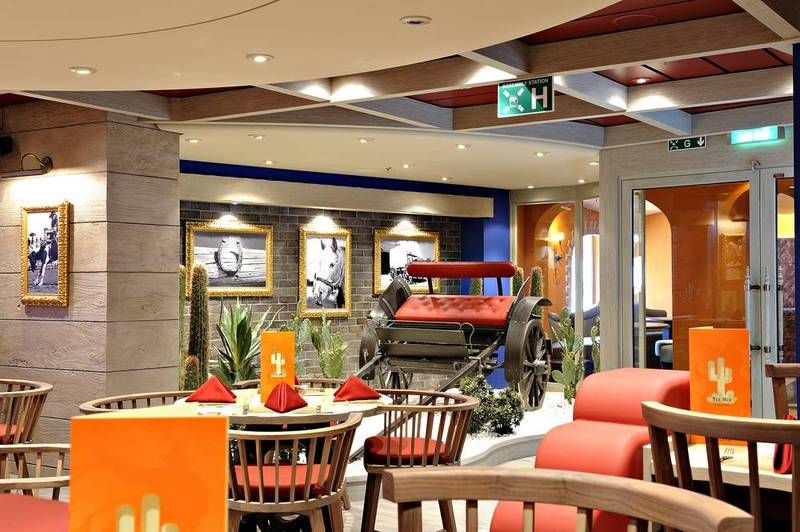
The Santa Fe Dining room is open for anytime dining at dinner time between 5.30pm and 10pm.
Santa Fe's speciality is chicken or steak fajitas.
The option of an 'always available menu' is also provided including steaks, chicken breast and salmon, along with healthy options.
The Santa Fe Dining Room is on the 6th Deck of the Diamond Princess.
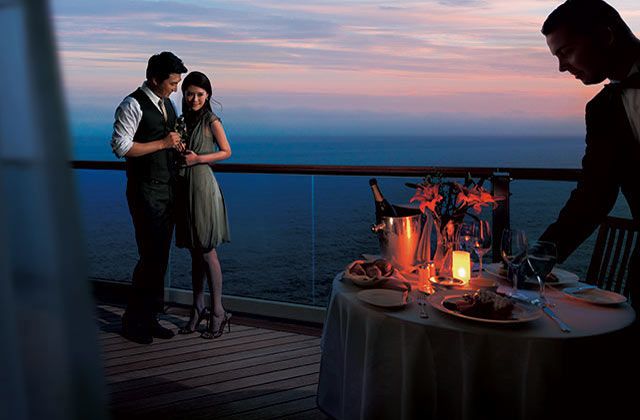
Choose a luxurious breakfast or experience the “ultimate” romantic dinner at sea: a sumptuous multi-course meal, including succulent lobster tail and juicy steak, your beverage of choice, hors d’oeuvres, all served right on the privacy of your own balcony by our dedicated waitstaff. Treat yourself to this unparalleled indulgence and savour food, views and memories that will never be forgotten.
Additional charges apply.
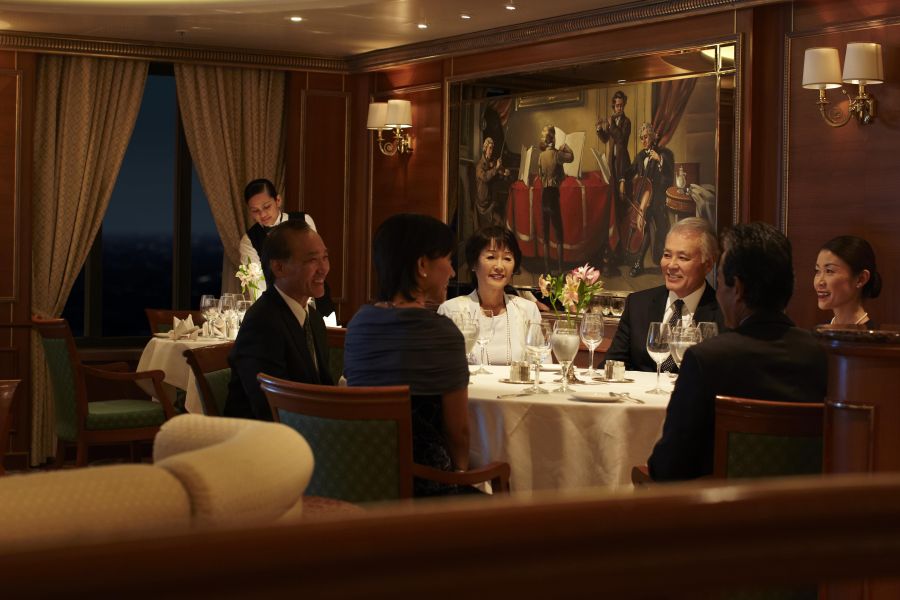
The Vivaldi Dining Room is open for traditional dining at 5.30pm or anytime dining between 8pm and 10pm.
The Vivaldi Dining Room is on the 5th Deck of the Diamond Princess.
The menu for all the main dining rooms serve the same four course dinner options with set choices with the exception of one speciality dish specific to each room.
The option of an 'always available menu' is also provided including steaks, chicken breast and salmon, along with Lotus Spa healthy options.
The images shown are for illustration purposes only and may not be an exact representation of what you find on the ship.
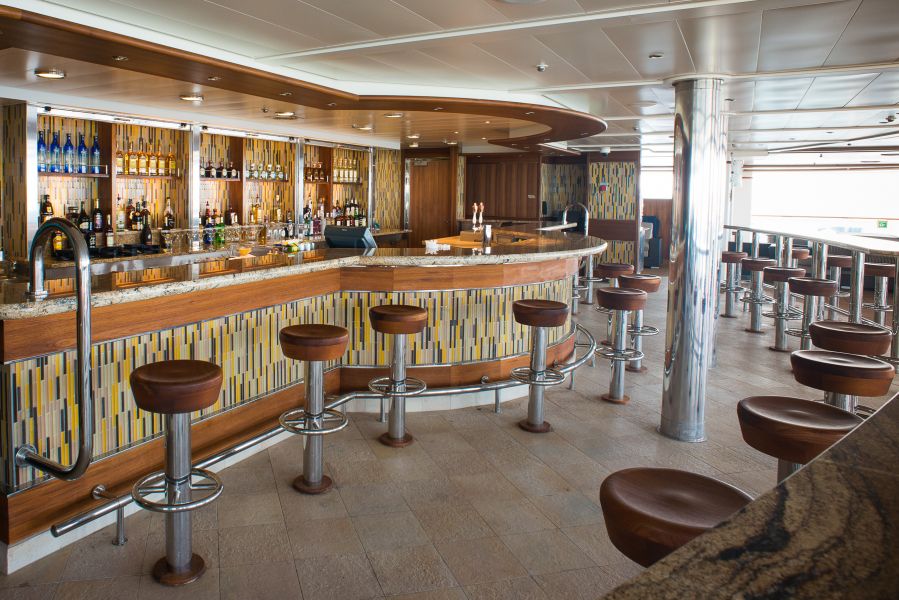
The Mermaids Tail bar serves the Neptune pool area and is located forward of the 14th Deck.
It also sells a small selection of sweets and chocolates, for guests to purchase whilst watching the movies under the stars at night on the large overhead TV screen.
The Oasis Bar serves the Sports Deck (16) and is located aft of the deck in between the two hot tubs.
Outrigger Bar is an outside bar aft of the 14th Deck serving the Horizon Terrace sundeck and pool below.
Calypso Bar serves the Calypso pool midship on the 14th Deck also.
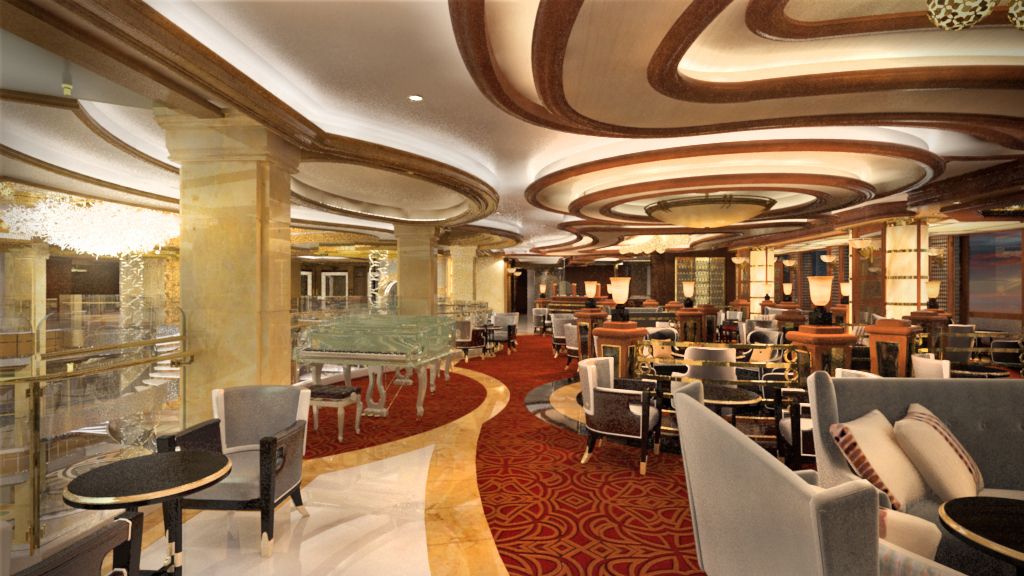
The Crooners Lounge and Bar, located midship on deck 7 opens from 1pm onwards and is reminiscent of a classic Martini bar.
Evening entertainment features live piano music with requests and name that tune elements. Here they also offer an enticing menu of 75 martinis, plus entertainers at spectacular duelling glass pianos.
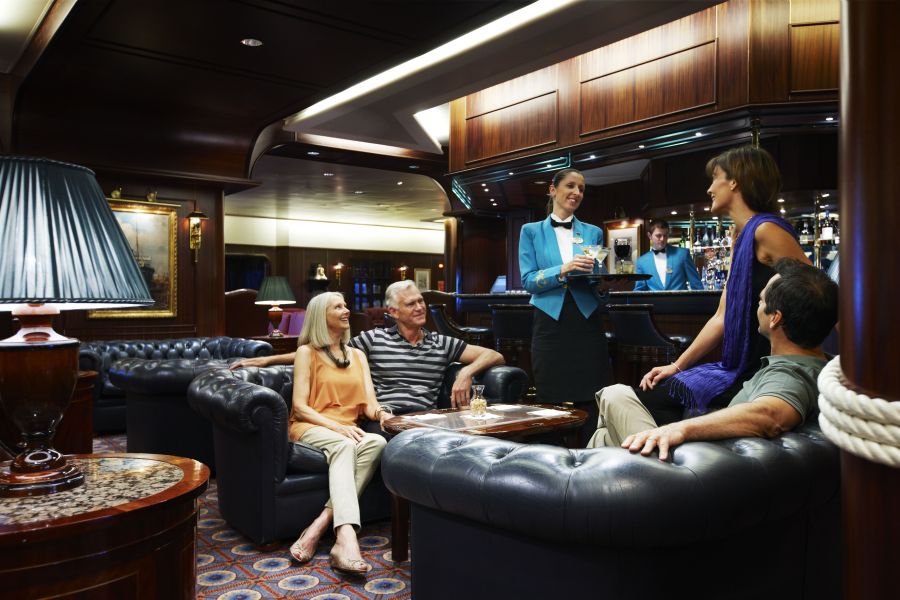
The Wheelhouse bar, located on the 7th Deck outside the theatre, serves premium beers, wines and spirits and is decorated in the style of a gentleman's club with leather armchairs and nautical artefacts.
It has its own dance floor, bar and stage where live music is played from.
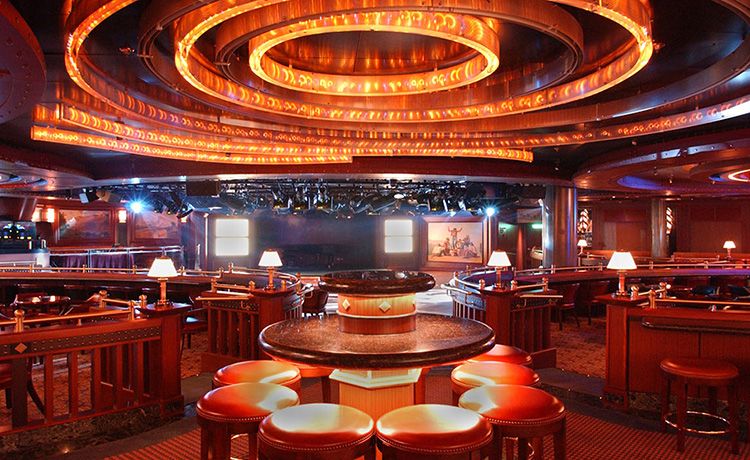
When the sun goes down and the moon comes up, it’s time to get your feet movin’ and your heart pumpin’ at Club Fusion. A little eclectic and a whole lot of fun, the dance floor lights and booming sound system invite you to get up and show off your moves and grooves. Karaoke contests, live performances and theme-parties like “60s British Invasion” are just a few of the nightly events that will have you on your feet.
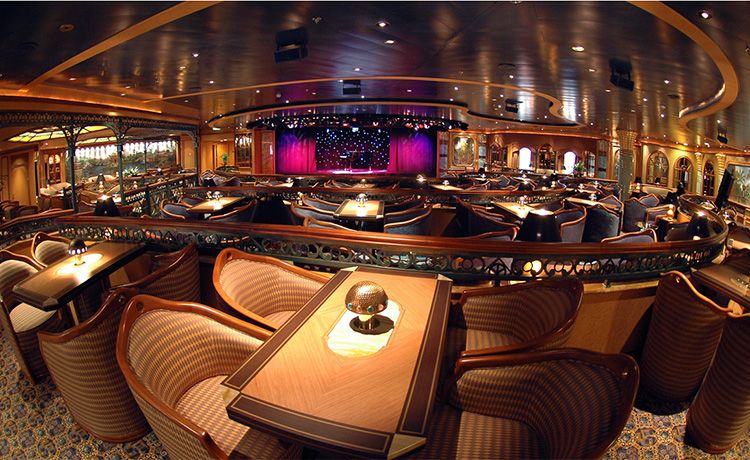
Explorers Lounge on the 7th Deck is Diamond Princess' second entertainment venue with its own dance floor, bar serving wine and cocktails and stage.
Entertainment on offer ranges from trivia quizzes during the day to comedians, live bands and themed nights in the evening.
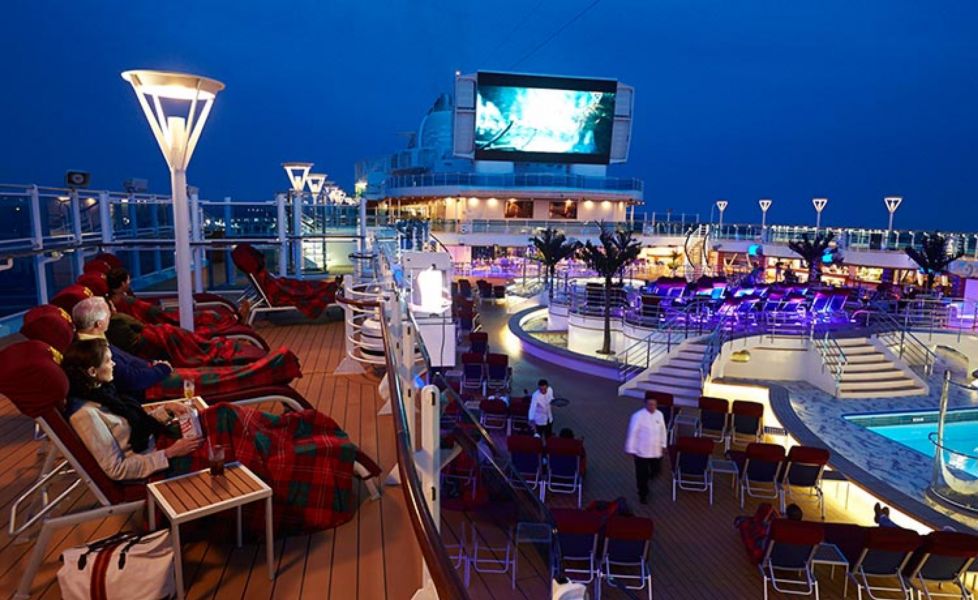
Throughout the day and night, our exclusive open-air poolside amphitheater is the go-to destination for feature films, thrilling concerts and exciting sporting events such as live football games. Cozy up under a fleece blanket in the comfortable lounger and feast on complimentary fresh-popped popcorn in the evening or delicious cookies and milk during the day, and enjoy that exciting car chase or mystery thriller on the giant screen.
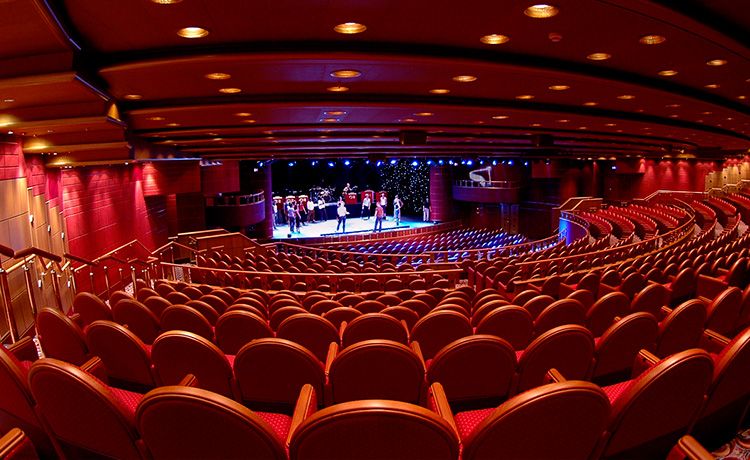
With dazzling stage sets, artists from around the globe, modern hits and timeless classics, the Princess Theatre, our largest theatre yet, showcases lavish, original productions with dynamic cast members in sumptuous surroundings. In this ultramodern theatre, relax in a plush seat with unobstructed sight lines as the velvet curtain goes up, a state-of-the-art lighting system illuminates the stage, and it’s on with the show!
The images shown are for illustration purposes only and may not be an exact representation of what you find on the ship.
The images shown are for illustration purposes only and may not be an exact representation of what you find on the ship.
| 22 nights aboard the Diamond Princess | |||
| Evening entertainment & Broadway style shows | |||
| Complimentary daily afternoon tea | |||
| Choice of traditional or anytime dining | |||
| Complimentary 24-hour room service | |||
| Speciality Restaurants (charges may apply) | |||
| Drinks package available | |||
| Port Taxes and Fees | |||
 | ABTA and ATOL Protection* | ||
Date 21st Feb 2025 |
Nts 22 |
Please Call for Availability |
Date 21st Feb 2025 |
Nts 22 |
Please Call for Availability |
| Interior staterooms |  | ||
| IA | Interior |  | |
| ID | Interior |  | |
| IC | Interior |  | |
| IE | Interior |  | |
| IF | Interior |  | |
| IB | Interior |  | |
| Oceanview staterooms |  | ||
| O5 | Premium Oceanview |  | |
| OV | Oceanview (Obstructed) |  | |
| OZ | Oceanview (Obstructed) |  | |
| OC | Oceanview |  | |
| OW | Oceanview (Obstructed) |  | |
| OY | Oceanview (Obstructed) |  | |
| OF | Oceanview |  | |
| Balcony staterooms |  | ||
| BD | Balcony |  | |
| BB | Balcony |  | |
| BE | Balcony |  | |
| BC | Balcony |  | |
| B4 | Premium Balcony |  | |
| BF | Balcony |  | |
| BA | Balcony |  | |
| B2 | Premium Balcony |  | |
| Suite staterooms |  | ||
| S1 | Grand Suite |  | |
| S5 | Premium Suite |  | |
| S6 | Vista Suite |  | |
| S2 | Owner's Suite |  | |
| S4 | Penthouse Suite |  | |
| S3 | Penthouse Suite |  | |
| S8 | Two Bedroom Family Suite |  | |
| M1 | Club Class Mini-Suite |  | |
| ME | Mini-Suite |  | |
| MD | Mini-Suite |  | |
| MB | Mini-Suite |  | |
Fusion Cruises when selling travel arrangements is a trading name of The Midcounties Co-operative Ltd. Fusion Cruises is an Accredited Body Member of Midcounties Co-operative Travel Consortium. (ABTA:P6652, ATOL:6053).
Book with Confidence. We are a Member of ABTA which means you have the benefit of ABTA’s assistance and Code of Conduct.
Some of the flights and flight-inclusive holidays on this website are financially protected by the ATOL scheme but ATOL protection does not apply to all holiday and travel services offered on this website. This website will provide you with information on the protection that applies in the case of each holiday and travel service offered before you make your booking. If you do not receive an ATOL Certificate then the booking will not be ATOL protected. If you do receive an ATOL Certificate but all parts of your trip are not listed on it, those parts will not be ATOL protected. Please see our booking conditions for information, or for more information about financial protection and the ATOL Certificate go to: www.caa.co.uk
